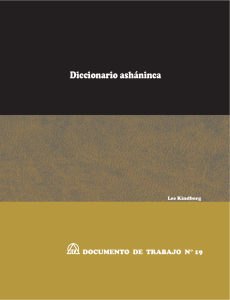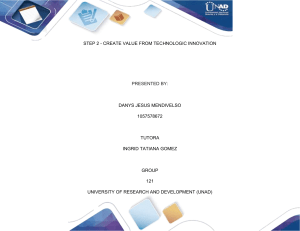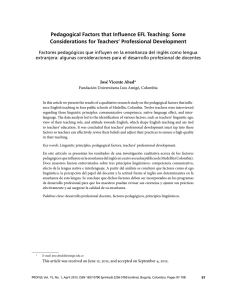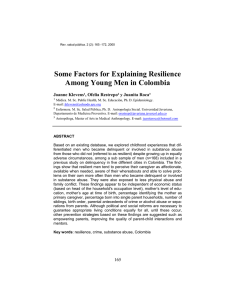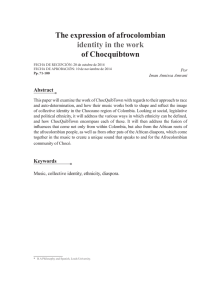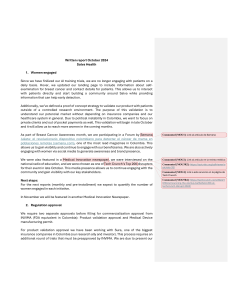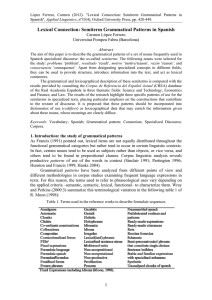Español 488 Language shift in the Spanish Speaking World José
Anuncio
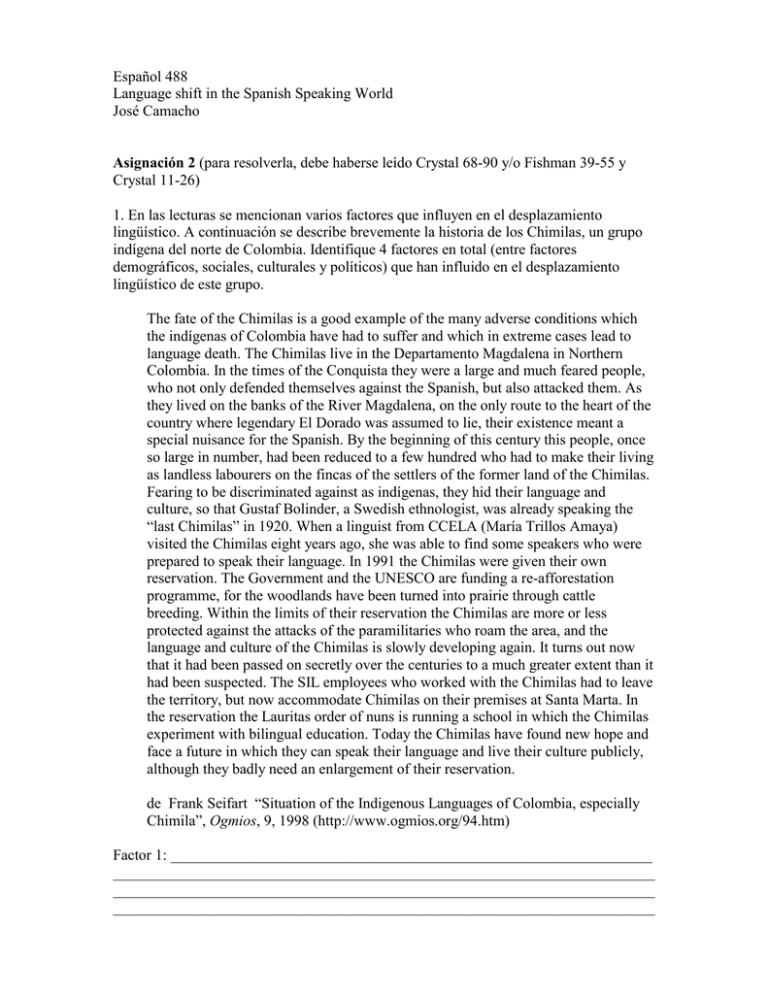
Español 488 Language shift in the Spanish Speaking World José Camacho Asignación 2 (para resolverla, debe haberse leído Crystal 68-90 y/o Fishman 39-55 y Crystal 11-26) 1. En las lecturas se mencionan varios factores que influyen en el desplazamiento lingüístico. A continuación se describe brevemente la historia de los Chimilas, un grupo indígena del norte de Colombia. Identifique 4 factores en total (entre factores demográficos, sociales, culturales y políticos) que han influido en el desplazamiento lingüístico de este grupo. The fate of the Chimilas is a good example of the many adverse conditions which the indígenas of Colombia have had to suffer and which in extreme cases lead to language death. The Chimilas live in the Departamento Magdalena in Northern Colombia. In the times of the Conquista they were a large and much feared people, who not only defended themselves against the Spanish, but also attacked them. As they lived on the banks of the River Magdalena, on the only route to the heart of the country where legendary El Dorado was assumed to lie, their existence meant a special nuisance for the Spanish. By the beginning of this century this people, once so large in number, had been reduced to a few hundred who had to make their living as landless labourers on the fincas of the settlers of the former land of the Chimilas. Fearing to be discriminated against as indígenas, they hid their language and culture, so that Gustaf Bolinder, a Swedish ethnologist, was already speaking the “last Chimilas” in 1920. When a linguist from CCELA (María Trillos Amaya) visited the Chimilas eight years ago, she was able to find some speakers who were prepared to speak their language. In 1991 the Chimilas were given their own reservation. The Government and the UNESCO are funding a re-afforestation programme, for the woodlands have been turned into prairie through cattle breeding. Within the limits of their reservation the Chimilas are more or less protected against the attacks of the paramilitaries who roam the area, and the language and culture of the Chimilas is slowly developing again. It turns out now that it had been passed on secretly over the centuries to a much greater extent than it had been suspected. The SIL employees who worked with the Chimilas had to leave the territory, but now accommodate Chimilas on their premises at Santa Marta. In the reservation the Lauritas order of nuns is running a school in which the Chimilas experiment with bilingual education. Today the Chimilas have found new hope and face a future in which they can speak their language and live their culture publicly, although they badly need an enlargement of their reservation. de Frank Seifart “Situation of the Indigenous Languages of Colombia, especially Chimila”, Ogmios, 9, 1998 (http://www.ogmios.org/94.htm) Factor 1: ________________________________________________________________ ________________________________________________________________________ ________________________________________________________________________ ________________________________________________________________________ Factor 2: ________________________________________________________________ ________________________________________________________________________ ________________________________________________________________________ ________________________________________________________________________ Factor 3: ________________________________________________________________ ________________________________________________________________________ ________________________________________________________________________ ________________________________________________________________________ Factor 4: ________________________________________________________________ ________________________________________________________________________ ________________________________________________________________________ ________________________________________________________________________ 2. Identifique 4 factores sociales y económicos que afecten la situación del español en New Brunswick. Factor 1: ________________________________________________________________ ________________________________________________________________________ ________________________________________________________________________ ________________________________________________________________________ Factor 2: ________________________________________________________________ ________________________________________________________________________ ________________________________________________________________________ ________________________________________________________________________ Factor 3: ________________________________________________________________ ________________________________________________________________________ ________________________________________________________________________ ________________________________________________________________________ Factor 4: ________________________________________________________________ ________________________________________________________________________ ________________________________________________________________________ ________________________________________________________________________ 3. Crystal argumenta que es muy difícil definir cuándo una lengua se encuentra en peligro basándose en el número de hablantes. Proponga tres razones por las que existe esta dificultad. Razón 1: ________________________________________________________________ ________________________________________________________________________ ________________________________________________________________________ ________________________________________________________________________ Razón 2: ________________________________________________________________ ________________________________________________________________________ ________________________________________________________________________ ________________________________________________________________________ Razón 3: ________________________________________________________________ ________________________________________________________________________ ________________________________________________________________________ ________________________________________________________________________ 4. Algunas personas argumentan que el Quechua (lengua hablada en América del Sur) está en peligro, a pesar de tener un número de hablantes relativamente alto (1.5 millones de hablantes en Cuzco solo). ¿Por qué puede ser esto? ________________________________________________________________________ ________________________________________________________________________ ________________________________________________________________________ ________________________________________________________________________ ________________________________________________________________________ ________________________________________________________________________ ________________________________________________________________________ ________________________________________________________________________ ________________________________________________________________________ ________________________________________________________________________ ________________________________________________________________________ ________________________________________________________________________





